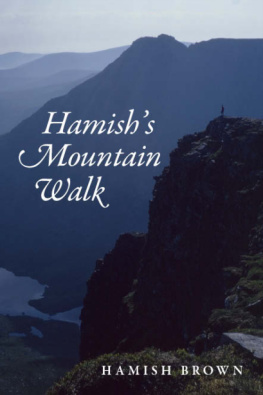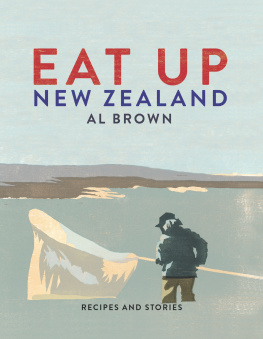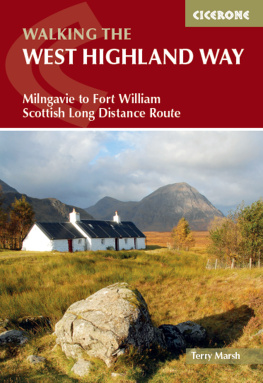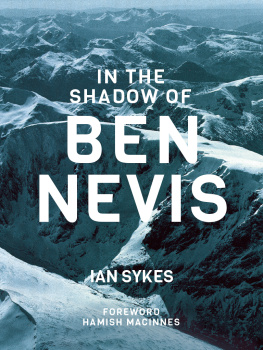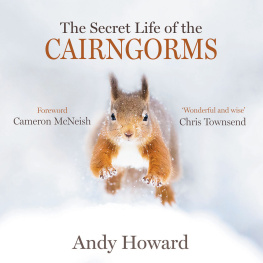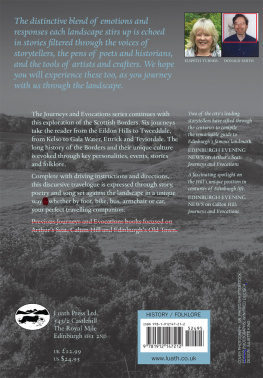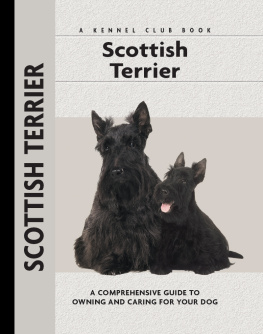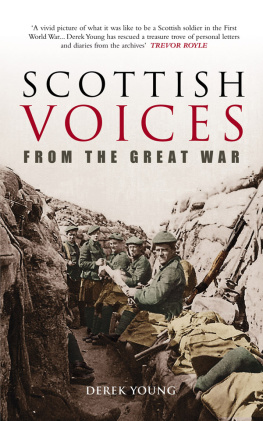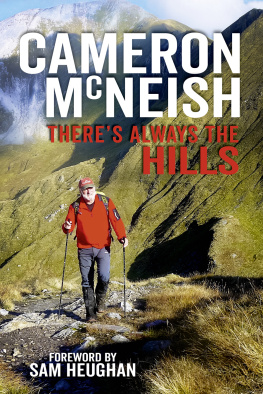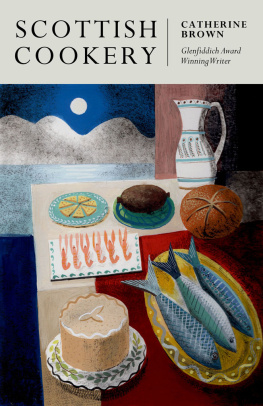ACKNOWLEDGEMENTS
My thanks to Jim Renny who drew the maps and to the Scottish Mountaineering Club for quotations from its Journal and also to Lovat Dickson for permission to quote Richard Hillarys The Last Enemy. Help was also gratefully received from Robin Campbell, Sandy Cousins, Jim Donaldson, John Hinde, Tom Weir and Tom Waghorn, many sadly no longer with us. Thanks too to family and friends who supported the venture and to Sheila Gallimore for her typing aid.
Appendix Corbetts adjacent to Munros
Section:
Ben Ime (Arrochar Alps). Six Corbetts in the group
Glen Lyon Munros. Some nearby Corbetts
Stuchd an Lochain. Two neighbours
Meall Ghaordie. Beinn nan Oighreag
Meall Glas. Beinn nam Imirean
Lawers (from pass). Meall nam Maigheach
Cruachan. Beinn a Bhuiridh
Creise. Beinn Mhic Chasgaig
Sgurr na h-Ulaidh. Meall Ligiche
Beinn Sgulaird. Creach Bheinn
Aonach Eagach. Garbh Bheinn
Beinn na Lap. Leum Ulleim
L. Ossian pair. Meall na Meoig
Drumochter. Two adjacent
Beinn Dearg. Beinn Mheadhonach
Lochnagar. Conachraig
Bynack More. Creag Mhor
Carn a Mhaim. Sgor Mor
A Chailleach. Carn an Fhreiceadain
Sgurr Thuilm. 10b. Streap
Gulvain. Neighbours
Sgurr na Ciche. Ben Aden
Sgurr Mor/Gairich. Sgurr an Fhuarain
Meall Buidhe. Beinn Buidhe
Ladhar Bheinn. Sgurr Coire Choinnichean
Beinn Sgritheall. Two neighbours
Sgurr na Sgine. The Siamese twins
Ciste Dhubh. Am Bathach
Sgurr nan Ceathreamhnan. Sgurr Gaorsaic
West of Loch Monar Three to work in
Maol Chean-dearg. An Ruadh-stac
Sgorr Ruadh. Fuar Tholl
Beinn Liath Mhor. Sgorr an Lochain Uaine
Beinn Eighe. Ruadh-stac Beag
Ben Wyvis. Little Wyvis
Conival. Breabag
CONTENTS

For family and friends who made the trip possible
GENESIS
Genesis is good for you! The decision to do this trip certainly was refreshing and though it was a snap decision in some ways I had no illusions about what was involved. So much of my reading at this time was of others doing things yet I was desk-bound and frustrated, kept from action even at my job.
It was around Halloween 1972 that I spread the map on the office floor and knew just what I would do in 1974. The period between was the Walk in some ways, the toil was there, not in the actual walking. Right from the start I knew it would be a largely solo trip. It would simplify a whole host of problems not even a committee of two to delay things and, God knows, Id had my fill of committees. Tentage, the doubling of every bit of food, finding a second cycle or canoe, the difficulty of back-up and above all finding the right person all these problems just did not happen. Close proximity with anyone over a long period, especially under stress, can be unhappy if not worse. Simplicity is the forgotten virtue.
I cannot recall when the actual timings were decided but obviously not immediately, as 1974 and not 1973 was chosen. I had some obligations to my job! That first winter, though, I doodled maps endlessly as I tried to link up the best line between the 277 summits. They even grew to 279 before I set off, as the O.S. caught up on their inadequate surveying of our North West. A mapboard faced desk/bed at home but of course much of it could be done in my head anyway. This gave me a pre-occupied air which some took for avid concentration on work in hand. One obvious joy would be the chance of activating what an old friend Willie Docherty called the creed of the long traverse.
The route clarified in general, though it was never static and in points altered even in the course of doing the trip. Sanely, not racing, how long would it take? I tackled this in various ways and the answer always seemed to be 34 months. May and June are usually the best months. There was the Stalking after July. That would suggest a start in early April; in fact the first of April seemed the obvious choice.
I went south-north both for romantic and practical reasons. I hoped for the better weather in the north and west. By starting on Mull I cut out one long arm. Bothies and huts in the north would help once into the midgy months, when the enjoyment of camping is apt to wear thin. All previous trips had been done north-south so perhaps there was an element of cussedness too.
The costing was approached from various angles and gave 400.
The route eventually was worked out on -inch maps which went to my brother so that he could follow my doings, and then the 1-inch which I used. I needed 22 maps in all. Both Dollar and I would have identical route-books with the day-to-day plans and a list of places where I would phone, a safety factor. I began to accumulate gear for the trip, selecting and testing breaking in three new pairs of boots till I knew they were comfortable over Christmas-New Year doing two weeks non-stop to see how the unfit body would take it. In January I began bringing in S.M.C. and B.F.M.C. friends who could act as weekend support and, when David (my brother) and his wife, Marina, agreed to act as base and even come as field support for the first part, I really felt a surge of faith that it would go. Later Mike Keates agreed to come out for the last two weeks in the north. David lived at Dollar in Clackmannanshire, Mike at Inverness, so this really covered the land.
I thought of sponsorship but as I had saved enough, it was not a desperate essential. If the Walk succeeded I could cash in a bit afterwards; but I wanted to enjoy it as my journey, untrammelled, and not as a public stunt. There was also the lure of the priority. This was not just my dream. Being first has its place, transient though it be; someone can always do it faster or shorter, cleaner or bolder, backwards or on their heads. The vital thing is to enjoy the doing of it.
As a keen canoeist I thought of canoeing to and from the islands (Mull and Skye) but this would be too great a risk of precious time. Later I did bring in the canoe for Loch Lomond. A cycle too could be used on the long, dull, tarred roads which could not easily be avoided. So long as it was all self-propelled it was valid.
I started using lunch breaks for wee jobs: mosaic-ing the maps to suit, trimming candles, preparing labels, making lists; at weekends in the north I would note the sites of telephone boxes and nibble away at the weight problem, endlessly trying variations of gear. I could not afford to buy much new stuff, so expediency played its part. My major worry was a tent. I had a good Vango featherweight but it had so many guys and bits and pieces and it was nylon which meant condensation problems. This became almost an obsession, but when Dave Challis heard he offered me a tent, also nylon, 3 1/2 lb weight, with, he said, no problem. I was sceptical!
He brought it to a conference later and pitched it on display. It was not even new. It was all mine. A few filthy weekends persuaded me he had been correct. There was condensation, but it did not matter; by the simple method of keeping the tray-shaped groundsheet away from the walls with elastic the condensation just ran into the ground.
Various courses and a season in the Alps gave a pause in the summer, and once back I handed in my notice so was free to do again: a Hebridean trip in November, a month on the schooner Captain Scott, then the usual holiday courses in the North West. Time suddenly was running out.
Back home it was already mid-January 1974. The stockpile came down from the loft, a last big shopping to the Alliance Cash and Carry (could I eat all that?), and from Hughes, our local grocer. The dates of a proposed visit to the Polish Tatras eventually became known and put the starting date back a few days.

